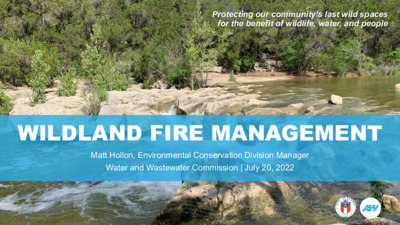Item 24 — original pdf
Backup

Protecting our community’s last wild spaces for the benefit of wildlife, water, and people WILDLAND FIRE MANAGEMENT Matt Hollon, Environmental Conservation Division Manager Water and Wastewater Commission | July 20, 2022 Growing WUI: Wildland Urban Interface WUI = area where structures and other human development meet or intermingle with natural vegetation More than 90% of fires are caused from human ignition Danger of fire spreading from a road, power line, or neighborhood into a preserve, or vice versa, increases as Austin urbanizes Forecast for hot, dry summer: we need to be prepared Presentation Outline Role of Wildland Conservation Division (WCD) Planning Overview Cooperative Projects Tools for Wildfire Preparedness AW Facilities and Operations Next Steps Role of Wildland Conservation Division The Wildland Conservation Division’s role in a Fire-Adapted Community is to manage fire use and fire potential to benefit watersheds, habitat, and public safety. Fuels Reduction Projects Ignition Prevention Prescribed Burning Ecological Restoration Cooperative Projects Long Range Planning Over 25,000 acres of land directly managed PLANNING OVERVIEW WCD Planning Overview Wildland programs have approved land management plans and adopted Best Management Practices for wildfire mitigation. Balcones Canyonlands Conservation Plan (BCCP) and permit (1996) Balcones Canyonlands Preserve land management plan (1999, 2007) Water Quality Protection Lands land management plan (2001, 2012, 2022*) * Currently in development. Wildfire Risk Modeling Hazard Determination 2009 - Fuels assessments and fire behavior modeling specific to the BCP produced by Baylor University as a part of the Community Wildfire Protection Plan (CWPP) 2012 - Refined methods for wildfire risk determination developed with AFD Wildfire Contingency Plans Across all AW Wildlands facilities and properties, hazard mapping is underway to inform strategic site planning and guide emergency responders Plans support individual and recurring Firewise assessments and fuel mitigation projects Wildfire Prevention Plans Wildfire Prevention Plans required prior to access for all City of Austin Wildland Conservation Division properties. Elements of these plans: Fire suppression equipment on site ID Fire department jurisdiction Wildfire spotter designation, name and phone # Emergency contacts This guarantees two-way protection for both conservation lands and infrastructure providers COOPERATIVE PROJECTS Cooperative Projects Austin/Travis County Wildfire Coalition Live Fuel Moisture Monitoring Program • Bi-monthly tracking since 2006 BCCP Collaborative Infrastructure Projects AFD Wildfire Division • Support Firewise messaging and outreach efforts to community groups and neighborhoods TOOLS FOR WILDFIRE PREPAREDNESS No ladder fuels Shaded Fuel Breaks Carefully planned thinning and removal of understory vegetation and ladder fuels. More fire protection, much less destructive than clear cutting. Typically 60-foot-wide treatment off property boundary (varies) Typically 4- to 8-foot-high trimming Shrubby underbrush only (<4 inches in diameter) All work occurs on COA side of fence Image credit: City of Richmond Planning Shaded Fuel Breaks: GIS Analysis and Dashboard Staff Training Collaborative wildfire training ongoing with AFD, county emergency service districts, and other local fire agencies. Incident Command System Wildland Urban Interface fire response Wildfire Cause Determination Courses in prescribed fire operations Prescribed Burning Helps accomplish land management goals Conducted by staff trained to highest standards set by national wildfire experts To ensure safety, conduct burns following strict protocols in a narrow window of environ. conditions Austin Fire Department involvement • Issues permits for prescribed burns within jurisdiction; provides on-site support 11,000 acres of Austin's Wildlands treated since 2001 AW FACILITIES AND OPERATIONS Climate resilience goals require equal parts hard work and thoughtful planning AW Facility Assessments • Facility assessments conducted to determine level of wildfire risk, offer solutions • Completed first phase of fuels reduction work at Ullrich Water Treatment Plant AW Facility Assessments AW Facility Assessments AW Facility Assessments Next Steps AW teams are working toward implementation of Facility Assessment recommendations Continue to work with partners e.g., AFD, PARD, and ACCC on Shaded Fuel Breaks Use projected impacts of climate change to inform land management and foster resilient landscapes For more information: austintexas.gov/wildlands Questions